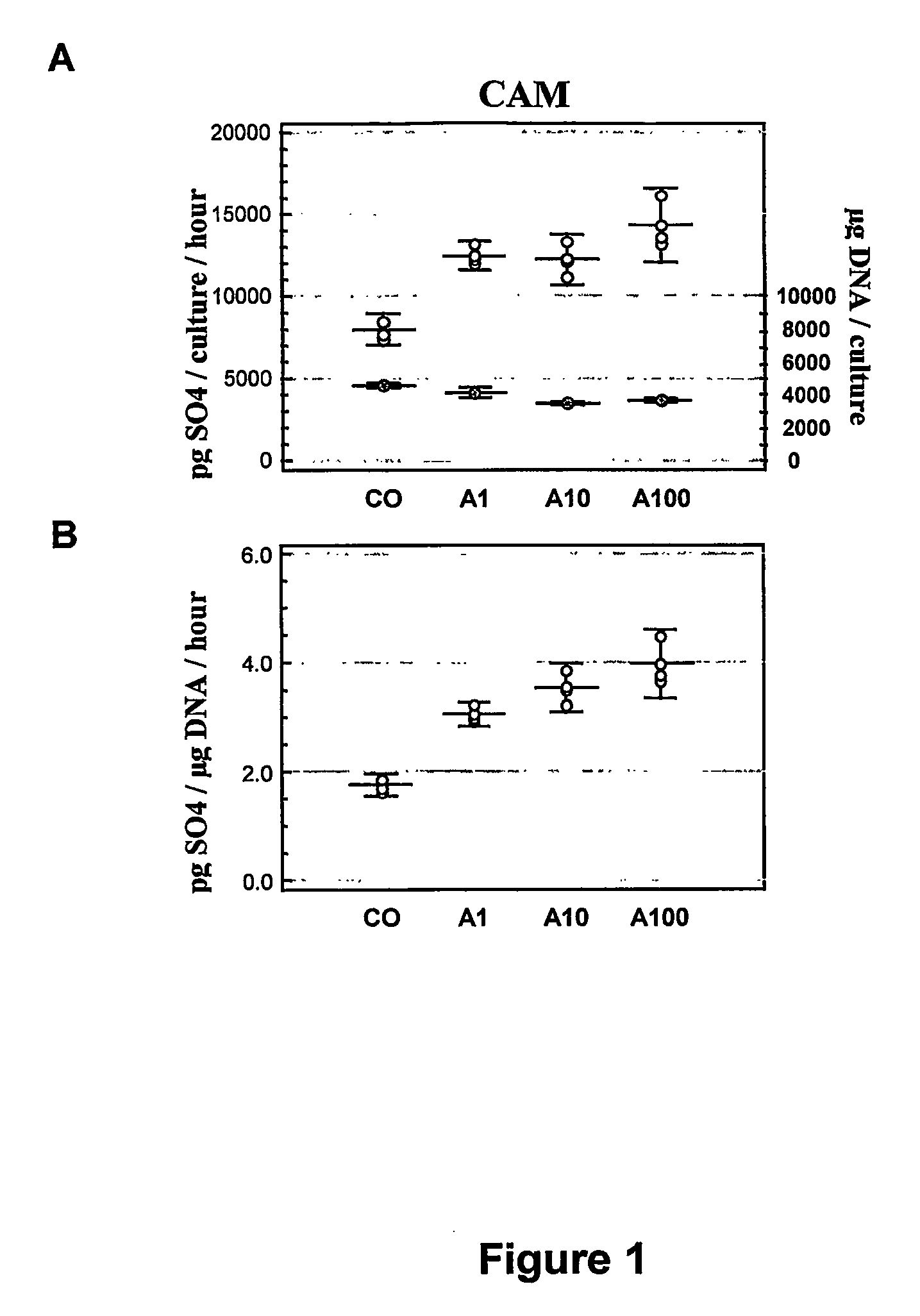Use of polysulphated alginate in cellular matrices
a technology of polysulphated alginate and cellular matrix, applied in the field ofmatrices, can solve the problems of osteoarthritis, inability of chondrocyte repair, etc., and achieve the effect of beneficial effect on the proliferation and production of extracellular matrix components
- Summary
- Abstract
- Description
- Claims
- Application Information
AI Technical Summary
Benefits of technology
Problems solved by technology
Method used
Image
Examples
example 1
Preparation of Polysulfated Alginate
[0048] Drop by drop, one vol. of Chlorosulphonic acid is added to 6.6 vol. ice-cold Pyridine. Approx. 300 mg of the alginate is added to 5 ml of the Chlorosulphonic / Pyridine mixture. The solution is then kept at 100° C. during 5 hours. After cooling, 25 ml of distilled water are added. 100 ml of 10% Na-Acetate in methanol are then added to this solution to precipitate the polysaccharide polysulphuric acids. The precipitate is washed 2 times in methanol and dissolved in an appropriate amount of pyrogen free distilled water to remove the remaining Chlorosulphonic acid, Pyridine and buffer salts. The precipitate containing the polysulphated alginate is lyophilized. The polysulphated alginate is recovered as a dry white powder.
[0049] The degree of sulphation and purity of the alginate as well as its pyrogen content was determined conventional chemical and biological methods. Under the conditions used, sulphation of alginate was found to be complete....
example 2
Evaluation of the in vitro Effects of Polysulphated Alginate on the Synthesis by Human Articular Cartilage Cells of Extracellular Matrix Aggrecans
Methodology
Isolation of Chondrocytes
[0050] Human articular chondrocytes were isolated as described by W. T. Green Jr (Clin. Orthop., 1971, 75:248-260) and K. E. Kuettner et al. (J. Cell. Biol., 1982, 93:743-750) with a few modifications (M. Cornelissen et al. J. Tiss. Cult. Meth., 1993, 15:139-146).
Incubation with Polysulphated Alginates
[0051] The articular cartilage cells were cultured in gelled alginate as described by P. D. Benya et al. (Cell, 1982, 30:215-224). The alginate contained different concentrations of alginate polysulphate prepared as described in Example 1.
Analysis of Aggrecan Synthesis
[0052] Synthesis of aggrecans was investigated using Na235SO4 as a radioactive precursor for 35Sulfated newly synthesized aggrecans by the chondrocytes in culture.
[0053] After a two-week culture period, 10 μCi / ml of the label was i...
example 3
Preparation of a Pharmaceutical Composition Comprising Polysulphated Alginates
[0060] Example of a formulation of 100 ml of gel containing polysulphated alginate for use as a matrix in the transplantation of human chondrocytes
polysulphated alginate (sodium salt)100μgalginate1gdouble concentrated DMEM antibiotics100ml
PUM
| Property | Measurement | Unit |
|---|---|---|
| concentration | aaaaa | aaaaa |
| concentration | aaaaa | aaaaa |
| concentration | aaaaa | aaaaa |
Abstract
Description
Claims
Application Information
 Login to View More
Login to View More - R&D
- Intellectual Property
- Life Sciences
- Materials
- Tech Scout
- Unparalleled Data Quality
- Higher Quality Content
- 60% Fewer Hallucinations
Browse by: Latest US Patents, China's latest patents, Technical Efficacy Thesaurus, Application Domain, Technology Topic, Popular Technical Reports.
© 2025 PatSnap. All rights reserved.Legal|Privacy policy|Modern Slavery Act Transparency Statement|Sitemap|About US| Contact US: help@patsnap.com

